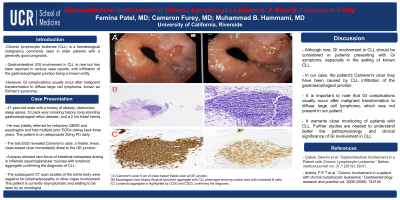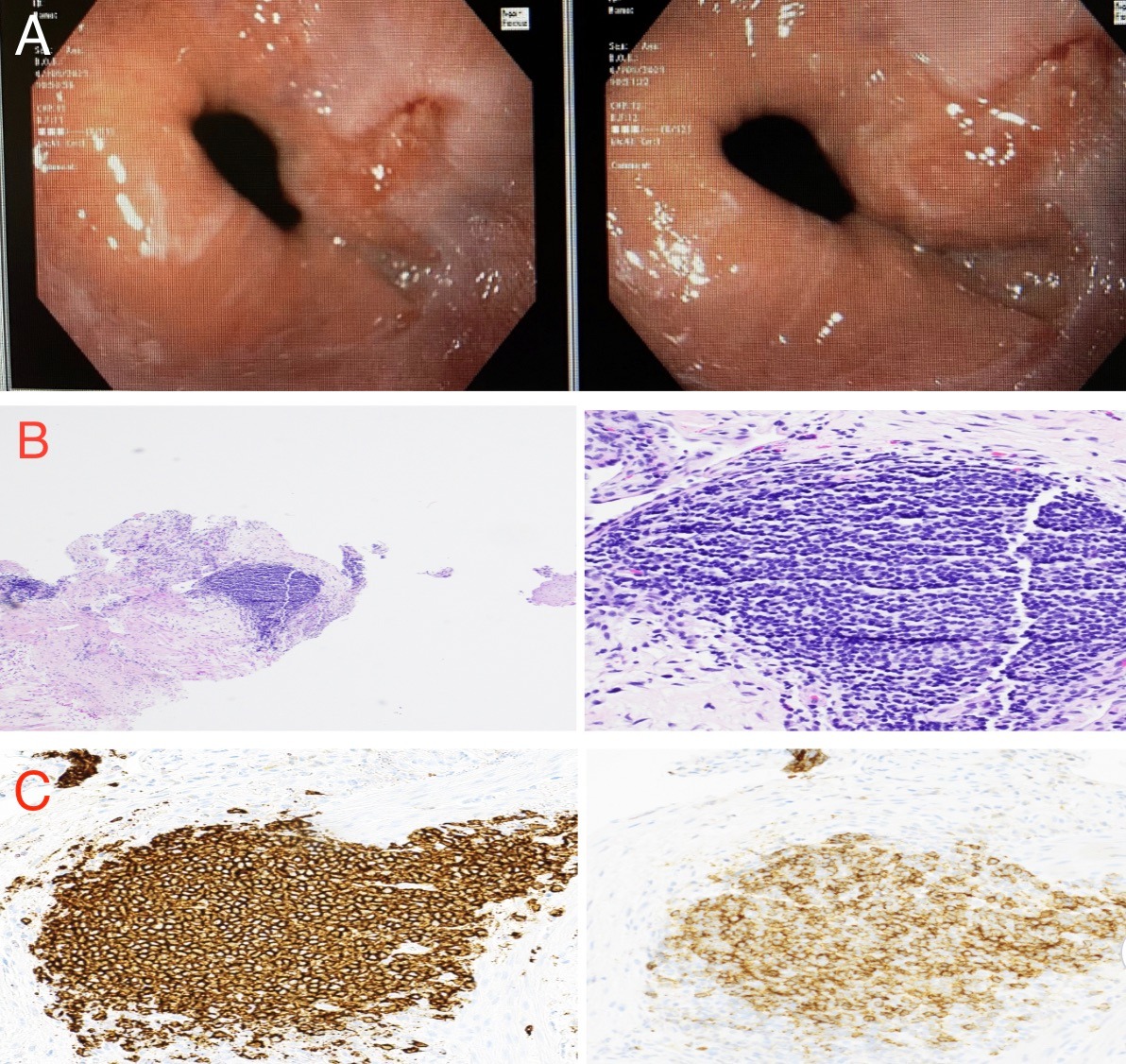Sunday Poster Session
Category: Esophagus
P0452 - Gastrointestinal Involvement in Chronic Lymphocytic Leukemia: A Rare but Important Entity
Sunday, October 22, 2023
3:30 PM - 7:00 PM PT
Location: Exhibit Hall

Has Audio
- FP
Femina Patel, MD
University of California Riverside
San Bernardino, CA
Presenting Author(s)
Femina Patel, MD1, Cameron Furey, MD1, Muhammad B. Hammami, MD2
1University of California Riverside, San Bernardino, CA; 2University of California Riverside, Riverside, CA
Introduction: Chronic lymphocytic leukemia (CLL) is a hematological malignancy commonly seen in older patients with a generally good prognosis. Gastrointestinal (GI) involvement in CLL is rare but has been reported in various case reports, with infiltration of the gastroesophageal junction being a known entity. However, GI complications usually occur after malignant transformation to diffuse large cell lymphoma, known as Richter's syndrome.
Case Description/Methods: We present a case of a 47-year-old male with a history of obesity, obstructive sleep apnea, 33 pack-year smoking history, long-standing gastroesophageal reflux disease, and a 2 cm hiatal hernia. He was initially referred for refractory GERD and esophagitis and had multiple prior esophagogastroduodenoscopies (EGDs) dating back three years. The patient is on rabeprazole 20mg PO daily. The last EGD revealed Cameron's ulcer, a friable, linear, clean-based ulcer immediately distal to the gastroesophageal junction. A biopsy showed rare focus of intestinal metaplasia arising in inflamed squamoglandular mucosa with lymphoid aggregate confirming the diagnosis of CLL. The subsequent CT scan studies of the entire body were negative for lymphadenopathy or other organ involvement. The patient is currently asymptomatic and waiting to be seen by an oncologist.
Discussion: Although rare, GI involvement in CLL should be considered in patients presenting with GI symptoms, especially in the setting of known CLL. In our case, the patient's Cameron's ulcer may have been caused by CLL infiltration of the gastroesophageal junction. It is important to note that GI complications usually occur after malignant transformation to diffuse large cell lymphoma, which was not present in our patient. It warrants close monitoring of patients with CLL. Further studies are needed to understand better the pathophysiology and clinical significance of GI involvement in CLL.

Disclosures:
Femina Patel, MD1, Cameron Furey, MD1, Muhammad B. Hammami, MD2. P0452 - Gastrointestinal Involvement in Chronic Lymphocytic Leukemia: A Rare but Important Entity, ACG 2023 Annual Scientific Meeting Abstracts. Vancouver, BC, Canada: American College of Gastroenterology.
1University of California Riverside, San Bernardino, CA; 2University of California Riverside, Riverside, CA
Introduction: Chronic lymphocytic leukemia (CLL) is a hematological malignancy commonly seen in older patients with a generally good prognosis. Gastrointestinal (GI) involvement in CLL is rare but has been reported in various case reports, with infiltration of the gastroesophageal junction being a known entity. However, GI complications usually occur after malignant transformation to diffuse large cell lymphoma, known as Richter's syndrome.
Case Description/Methods: We present a case of a 47-year-old male with a history of obesity, obstructive sleep apnea, 33 pack-year smoking history, long-standing gastroesophageal reflux disease, and a 2 cm hiatal hernia. He was initially referred for refractory GERD and esophagitis and had multiple prior esophagogastroduodenoscopies (EGDs) dating back three years. The patient is on rabeprazole 20mg PO daily. The last EGD revealed Cameron's ulcer, a friable, linear, clean-based ulcer immediately distal to the gastroesophageal junction. A biopsy showed rare focus of intestinal metaplasia arising in inflamed squamoglandular mucosa with lymphoid aggregate confirming the diagnosis of CLL. The subsequent CT scan studies of the entire body were negative for lymphadenopathy or other organ involvement. The patient is currently asymptomatic and waiting to be seen by an oncologist.
Discussion: Although rare, GI involvement in CLL should be considered in patients presenting with GI symptoms, especially in the setting of known CLL. In our case, the patient's Cameron's ulcer may have been caused by CLL infiltration of the gastroesophageal junction. It is important to note that GI complications usually occur after malignant transformation to diffuse large cell lymphoma, which was not present in our patient. It warrants close monitoring of patients with CLL. Further studies are needed to understand better the pathophysiology and clinical significance of GI involvement in CLL.

Figure: ( A) Cameron's ulcer 5 cm of clean-based friable ulcer at GE junction.
(B) Esophageal ulcer biopsy:Atypical lymphoid aggregate with CLL phenotype showing central area with increased B cells
(C) Lymphoid aggregate is highlighted by CD20 and CD23, confirming the diagnosis.
(B) Esophageal ulcer biopsy:Atypical lymphoid aggregate with CLL phenotype showing central area with increased B cells
(C) Lymphoid aggregate is highlighted by CD20 and CD23, confirming the diagnosis.
Disclosures:
Femina Patel indicated no relevant financial relationships.
Cameron Furey indicated no relevant financial relationships.
Muhammad Hammami indicated no relevant financial relationships.
Femina Patel, MD1, Cameron Furey, MD1, Muhammad B. Hammami, MD2. P0452 - Gastrointestinal Involvement in Chronic Lymphocytic Leukemia: A Rare but Important Entity, ACG 2023 Annual Scientific Meeting Abstracts. Vancouver, BC, Canada: American College of Gastroenterology.
